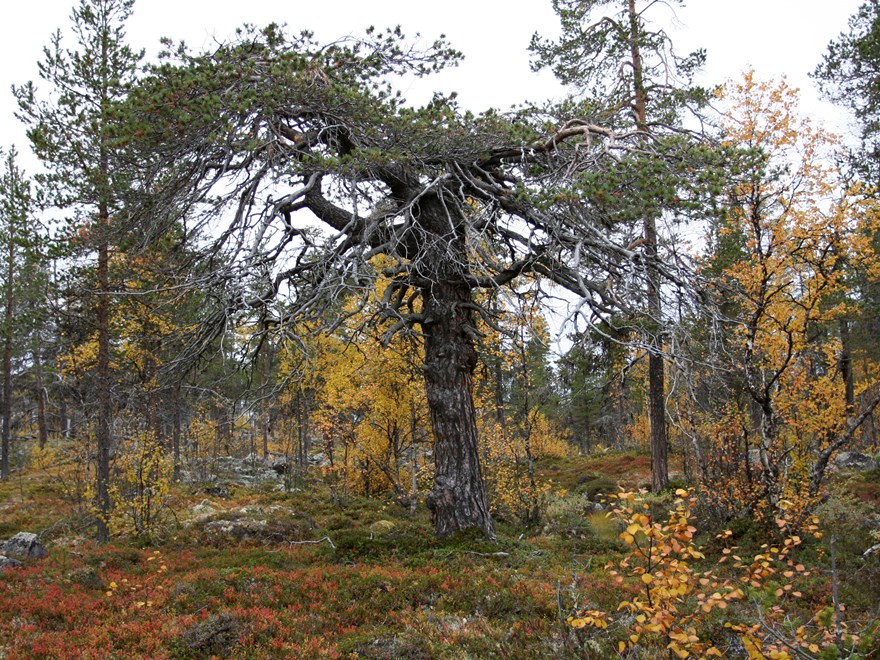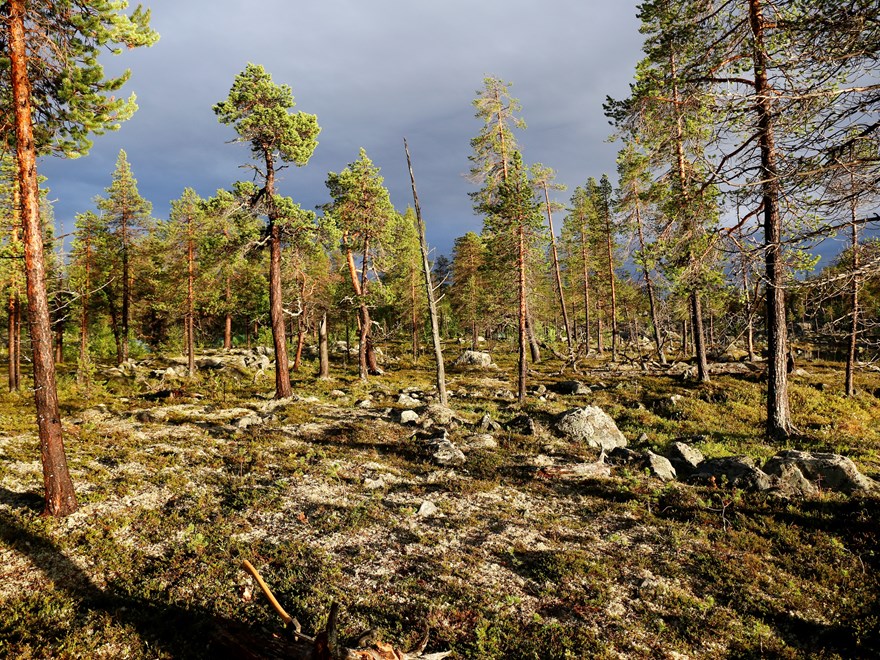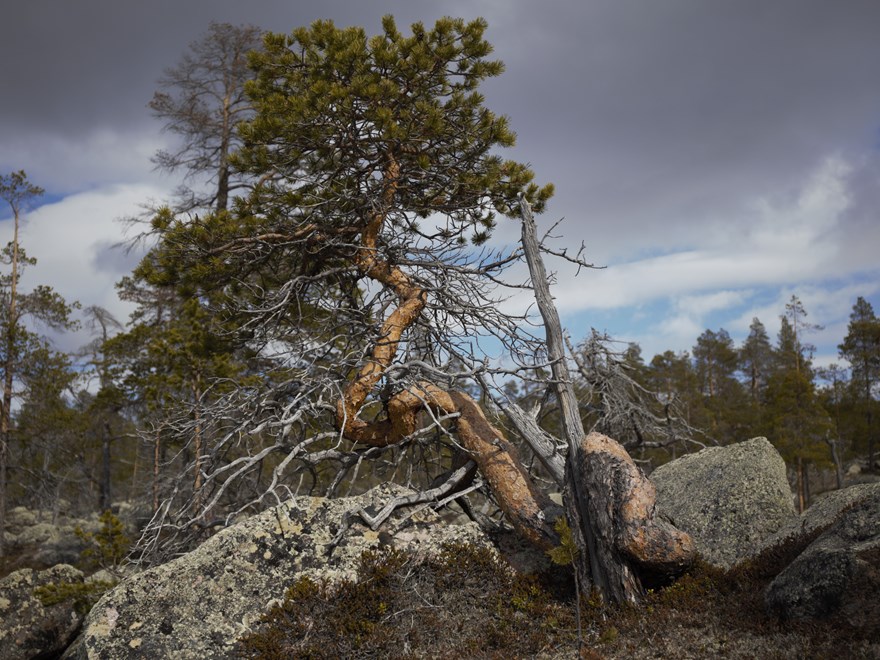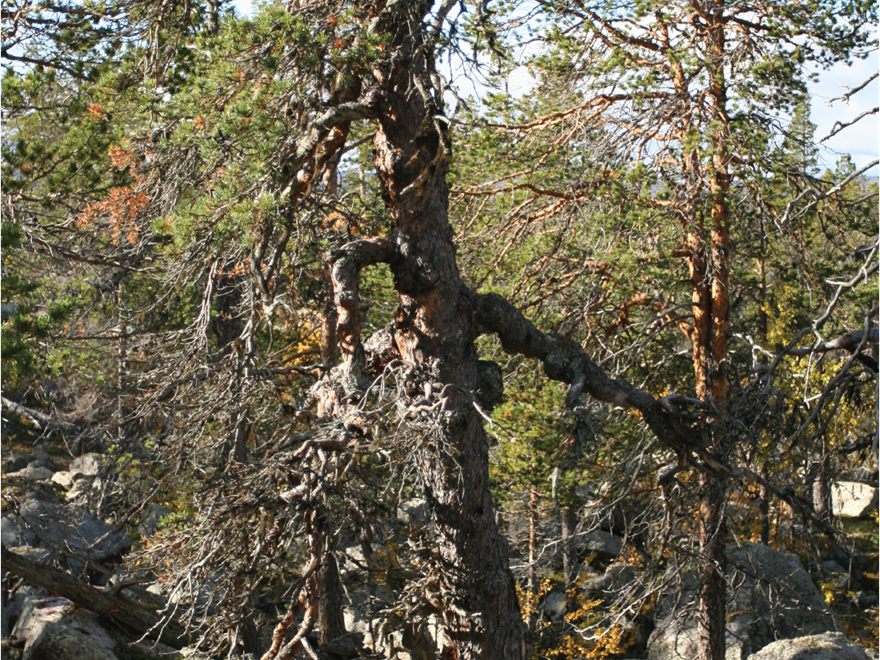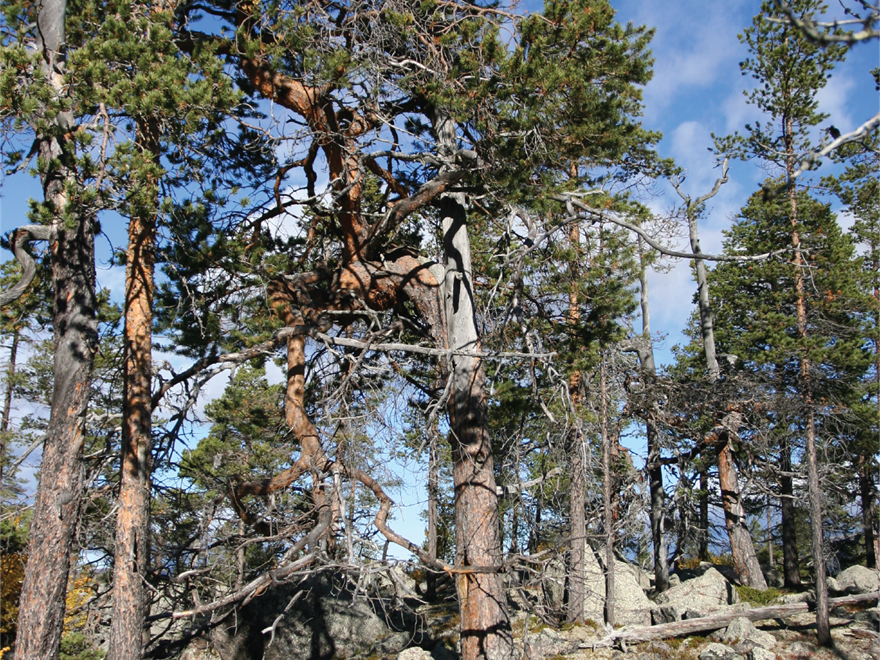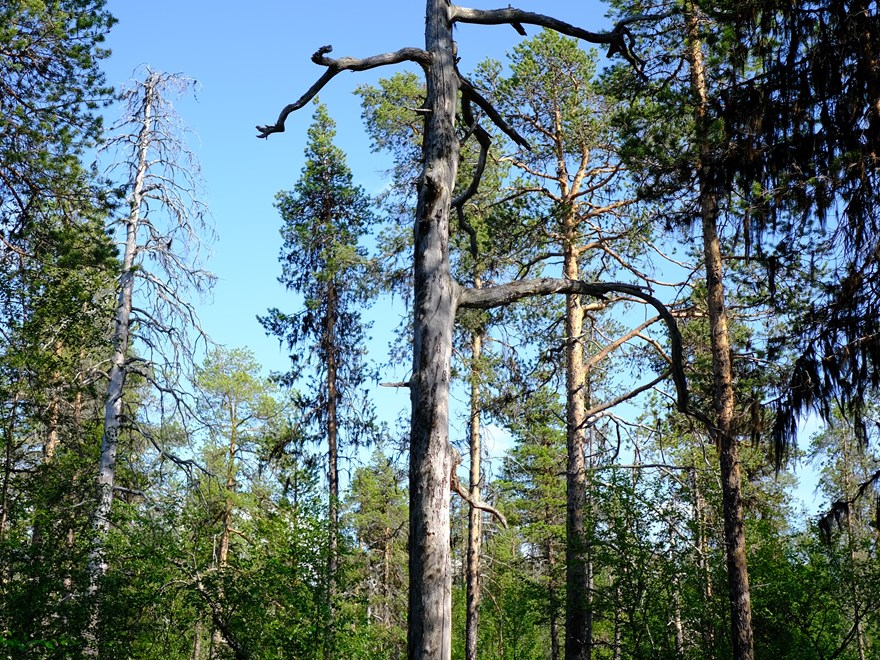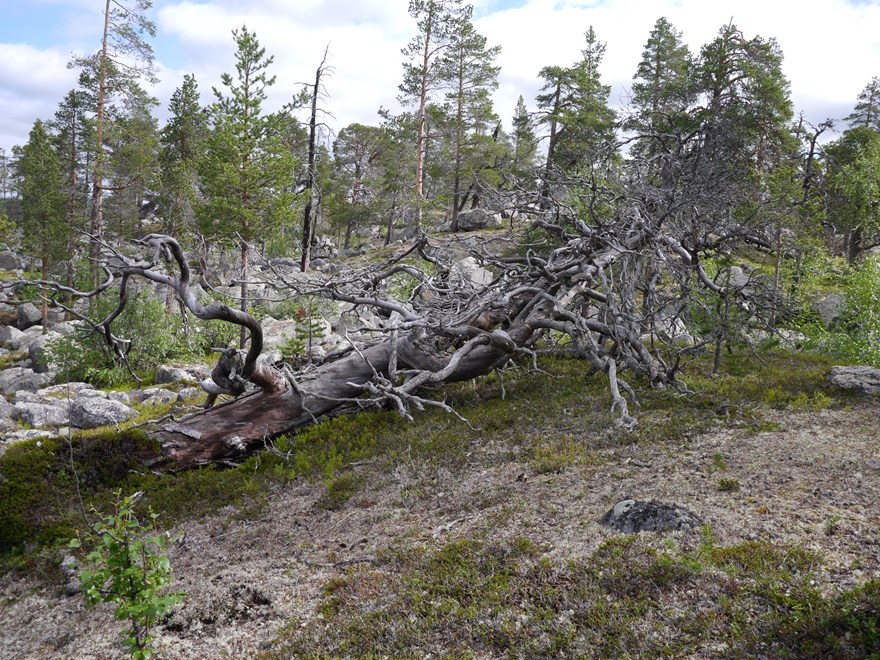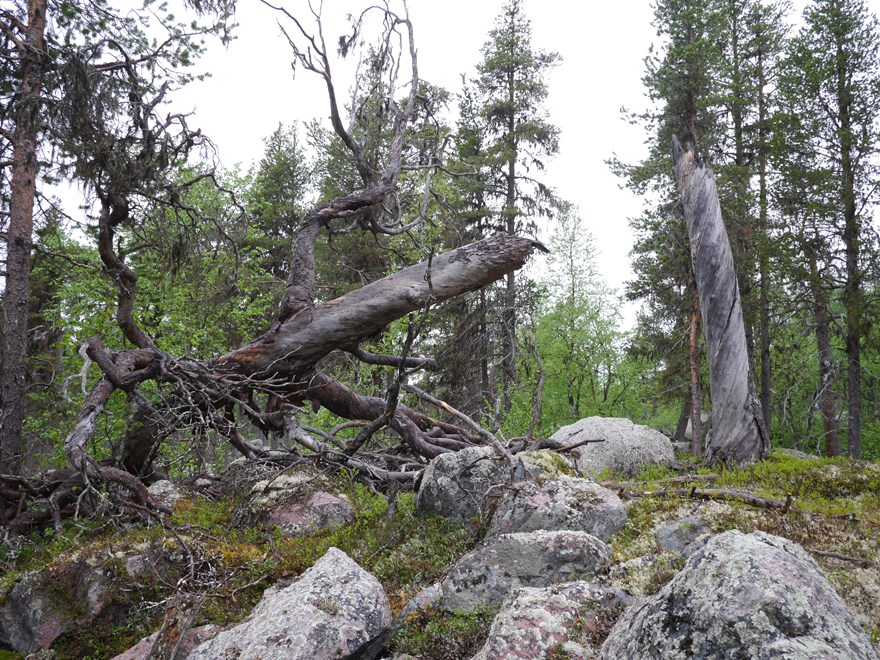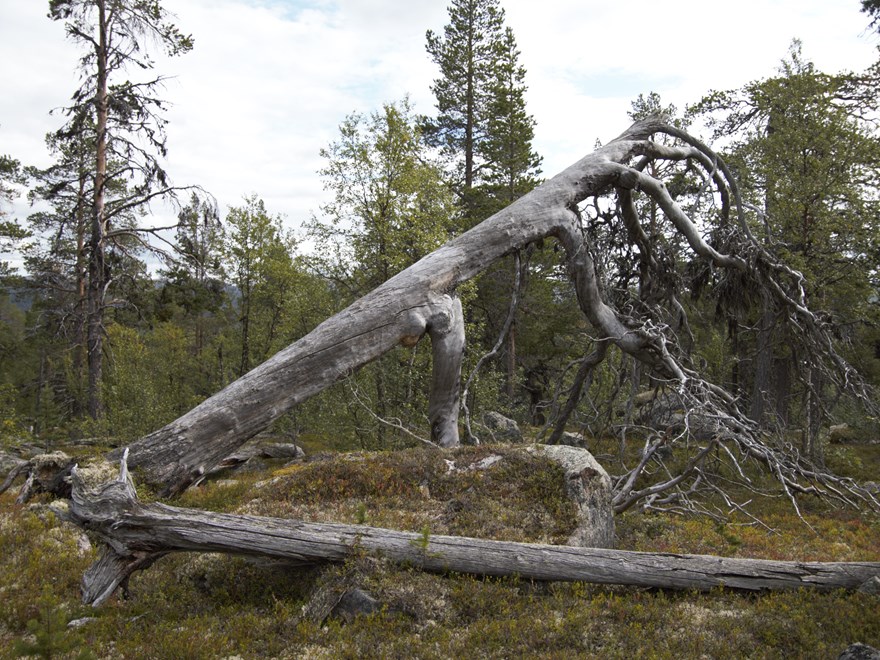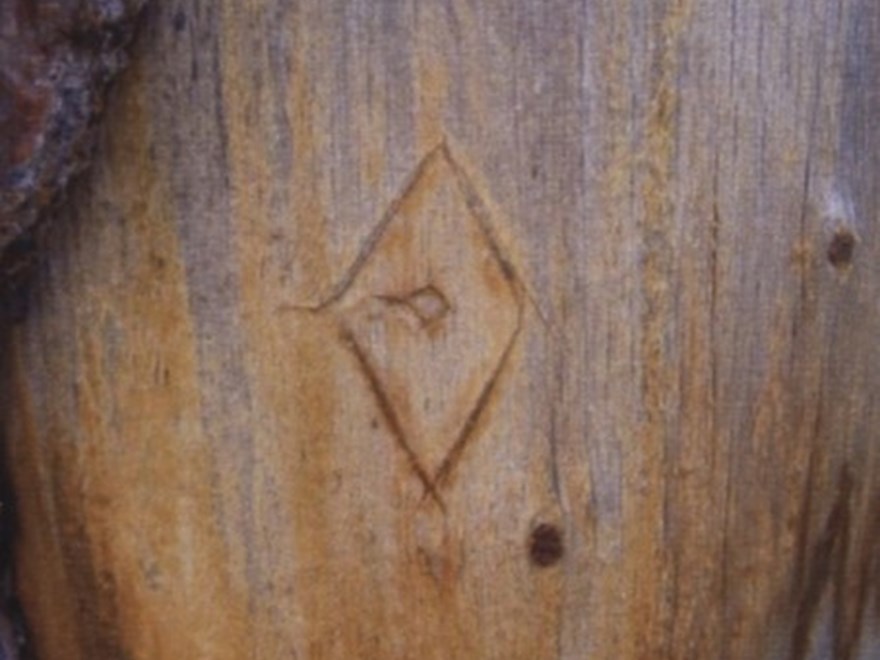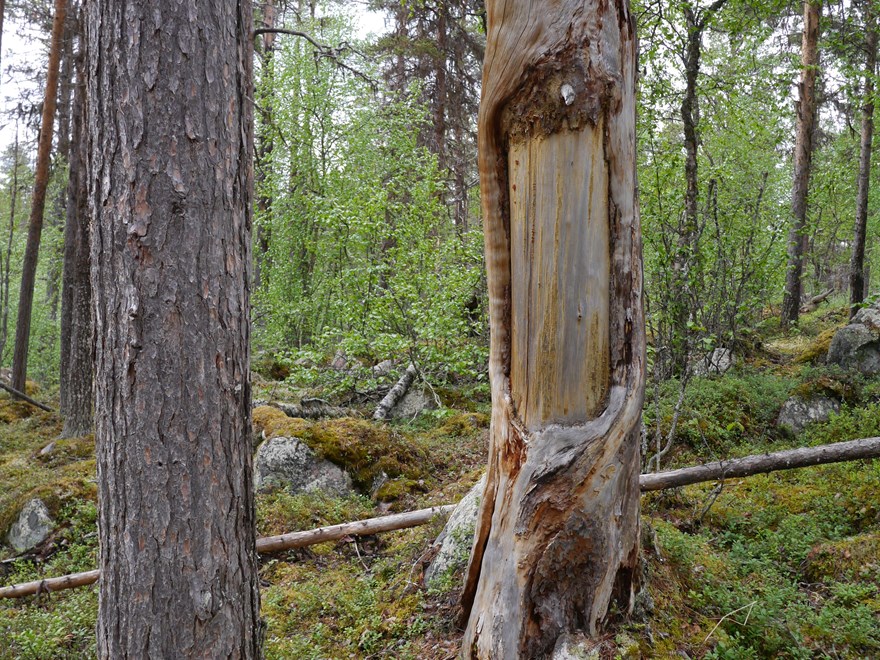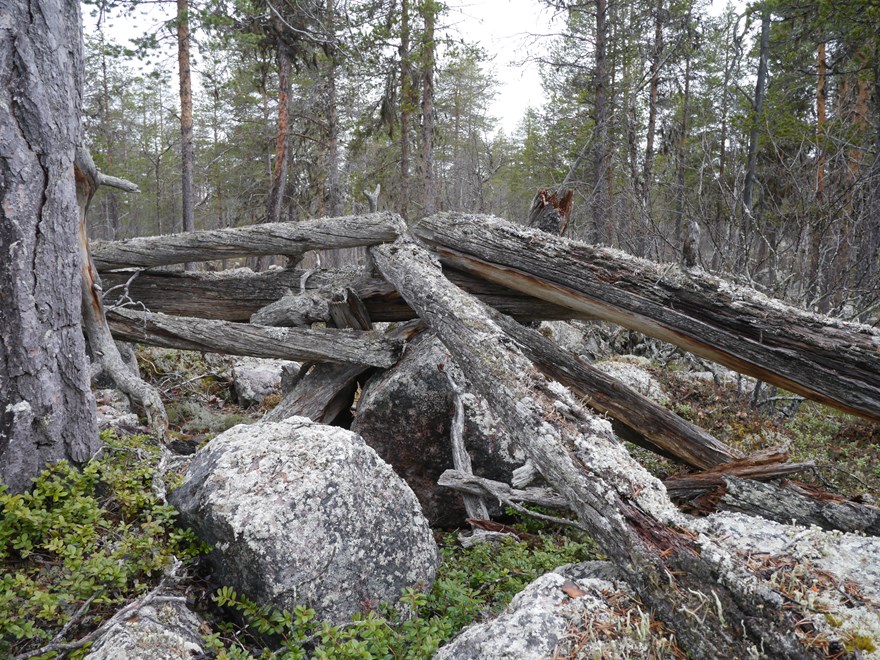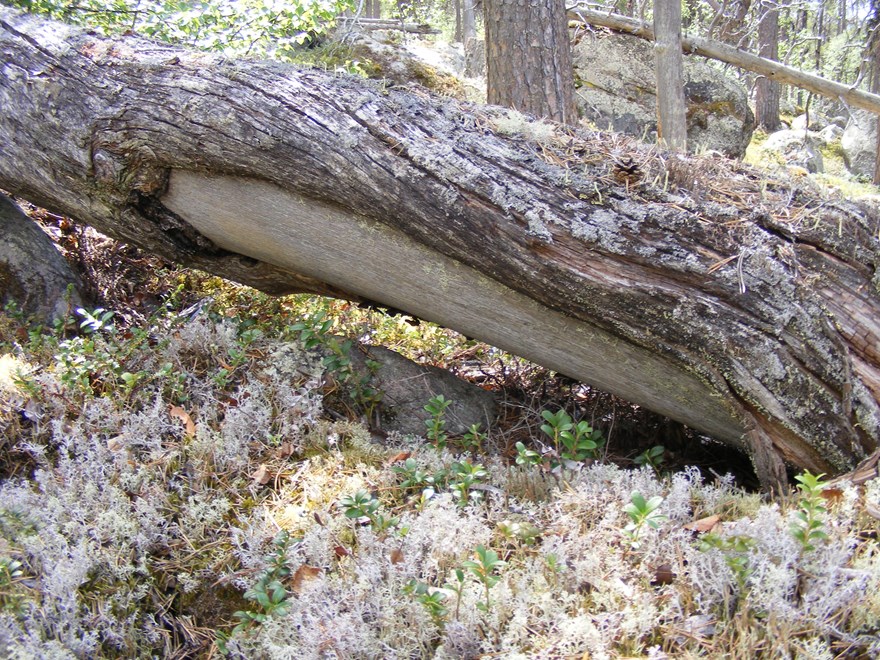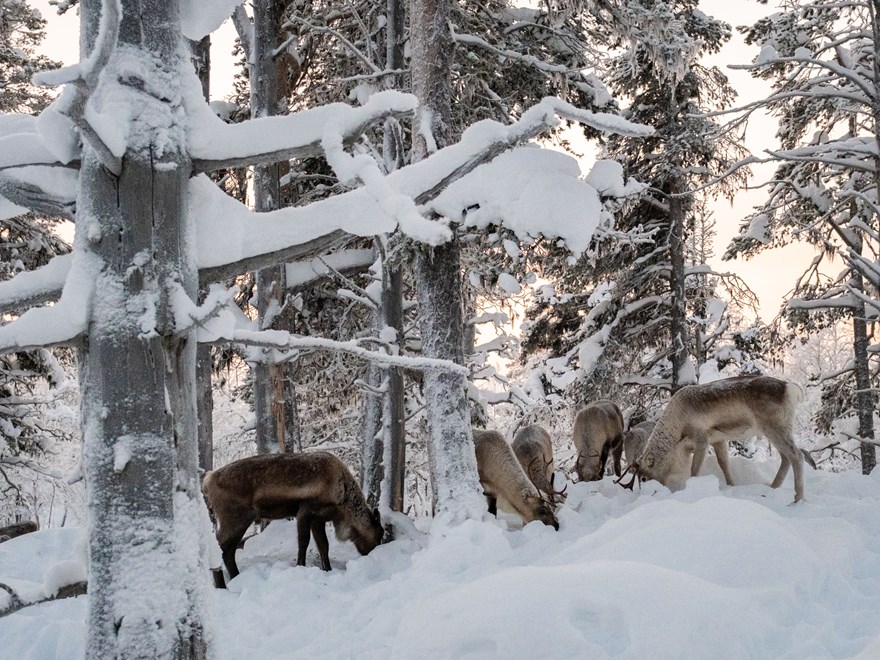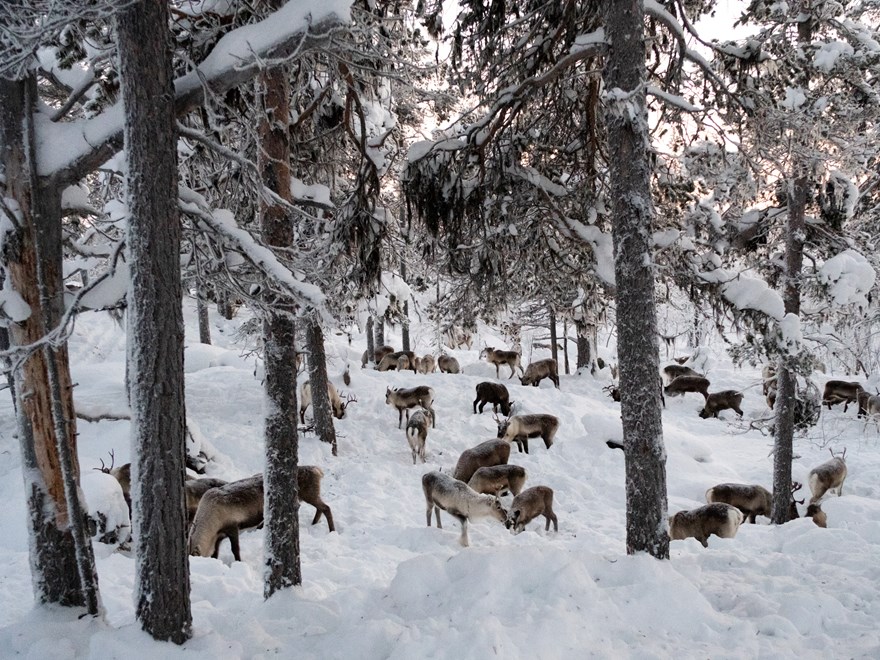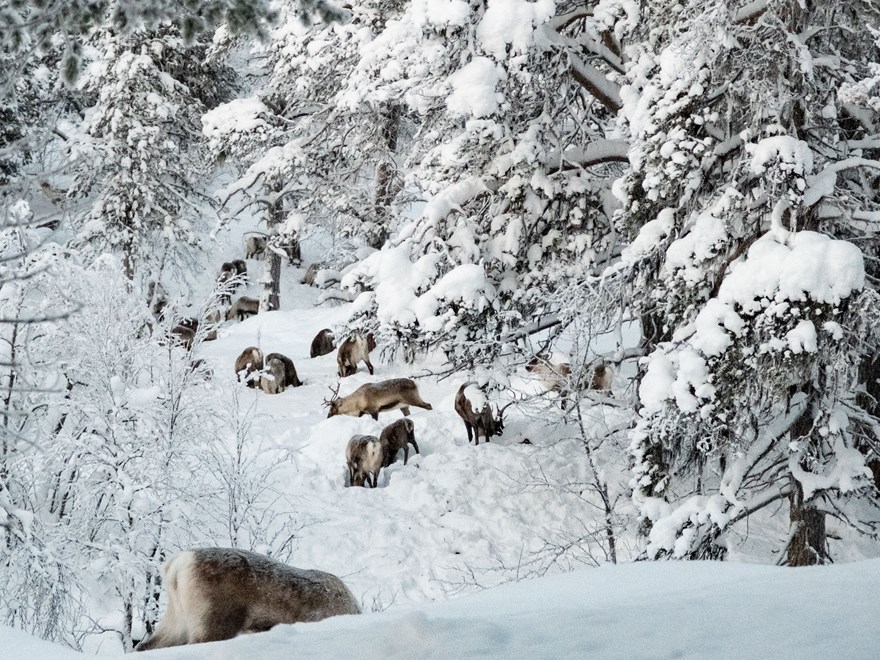Vattme/Tjeggelvas – a natural forest with cultural and historical values
The forest landscape in Vattme is both a natural forest and a cultural landscape and together this creates a fantastic forest that is unique both in Sweden and globally.
This project is in colloberation with:
Lars Östlund, Professor vid SLU, Magdalena Fassl, doktorand vid SLU, Petter Sjaggo, renskötare Luokta-Mavas sameby

Vattme, also known as Tjeggelvas nature reserve, is not only Sweden's finest natural tall forest, but also a Sami cultural landscape with a rich and unique history. Is it then primarily a natural forest or a cultural landscape? Give that some thought. Is it possible to think slightly contradictory thoughts at the same time or do we need a new concept for this type of forest?
The area is approximately 70 kilometres north of Arjeplog at the Arctic Circle and covers more than 300 km2 by the large and deep lake Tjeggelvas. Vattme includes many different types of natural pine forest, but one of the most interesting parts is north of the lake. There are no roads here, but an extensive mosaic of forest, lake systems, running water, bog and rough block fields. Due to this difficult accessibility and distance from the coast, Vattme has never been affected by either early logging in the 19th century (so-called dimensional logging) or modern forestry in the 20th century. It is very unusual in the Swedish forest landscape, but means that there are still really old pine forests with many trees aged between 200 and 500 years and a few really old trees that are over 700 years old. Finding so many trees that have approached their maximum biological age is one of the most fascinating things about this forest, because it means that the trees have developed characters and personalities that are no longer found in the normal forest.

In the forest in Vattme there are also many dead trees; trees that have died in a forest fire, blown over or simply died of old age. These dead trees are incredibly important to the ecosystem and give life to fungi, insects and birds. There is also a continuous influx of dead trees, each year hundreds of trees die and others grow up in their place. All these dead trees give a special character to Vattme and one never ceases to be fascinated by their varying forms and by the fact that they may have been dead for many hundreds of years. Standing dead pines with a gray surface without bark and really hard reddish wood are called "Kelo trees".
Although the forest mainly consists of older pine forest with elements of mountain birch, it varies considerably within the area; some parts consist of large block fields with occasional very old pines, in other more fertile parts the forest grows higher with a mix of trees of different ages. At some of the larger streams there are stretches of pure birch forest, in some cases with really birches that can be several hundred years old. As you hike up towards the mountain moors, the pine forest gradually turns into mountain birch forest. Single pines, however, grow high up in the mountain birch forest, where some rejuvenation of new pines occurs today.
Here you can read more about
The forest in Vattme and the ecological qualities found there
Josefsson, T & Östlund, L (2010) Urskogen finns inte mer – leve naturskogen!. Forskning och Framsteg (okt 2010).
Josefsson, T,., Gunnarson, B., Liedgren, L.G., Bergman, I. & Östlund, L. 2010. Historical human influence on forest composition and structure in boreal Fennoscandia. Canadian Journal of Forest Research 40:872-884.
Josefsson, T., Hörnberg, G. & Östlund, L. 2009. Long-term human impact and vegetation changes in a boreal forest reserve: implications for the use of protected areas as ecological references. Ecosystems 12:1017-1036.
Rautio, A-M, Josefsson, T., Axelsson, A-L. & Östlund, L. (2016) People and pines 1555–1910: integrating ecology, history and archaeology to assess long-term resource use in northern Fennoscandia. Landscape Ecology. 31(2), 337-349
Garcia Gil. R, Floran, V, Östlund, L Mullin, T-J. Andersson Gull, B (2015) Genetic diversity and inbreeding in natural and managed populations of Scots pine. Tree Genetics & Genomes, 11: 28
Josefsson, T., Olsson, J. & Östlund, L. 2010. Linking forest history and conservation efforts: effects of logging on forest structure and diversity of wood-inhabiting fungi. Biological Conservation 143:1803-1811.
Why the forest in Vattme (and other areas nearby) aren’t affected by logging and modern forest industry
Josefsson, T & Östlund, L (2010) Urskogen finns inte mer – leve naturskogen!. Forskning och Framsteg (okt 2010).
Östlund, L., & Norstedt, G. (2022). Preservation of the cultural legacy of the indigenous Sami in northern forest reserves – Present shortcomings and future possibilities. Forest Ecology and Management, 502, 119726.
Josefsson, T,., Gunnarson, B., Liedgren, L.G., Bergman, I. & Östlund, L. 2010. Historical human influence on forest composition and structure in boreal Fennoscandia. Canadian Journal of Forest Research 40:872-884.
Cosatti, Alice, 2022. The end of the timber frontier in northern Sweden : early logging, natural forests and the frontier concept. Avancerad nivå, A2E. Umeå: SLU, Institutionen för skogens ekologi och skötsel
Forest fires, their importance for the forests, and how it affects sami reindeer herding.
Cogos, S., Östlund, L., & Roturier, S. (2021). Fire Management in The Boreal Forest of Swedish Sápmi: Prescribed Burning and Consideration of Sami Reindeer Herding During 1920 –1970. Environmental Management, 68(3), 295-309.

At the same time as the forest in Vattme is one of Sweden's most valuable natural forests, it is also a many-thousand-year-old Sami cultural landscape. The forest is full of traces of Sami landscape exploitation that has accumulated over a very long time. The area consists of Sami Lapland tax lands where different families have paid taxes to the Swedish state for the right to use a certain area. Within Vattme there are hearths (characteristic Sami fireplaces), old trees with traces of bark extraction (where the pine's inner bark was harvested as food) as well as wood engravings. There are also lichen stumps (trees felled to give pure hanging lichen), roosts with birch forest, fishing rafts in ponds and lakes, hunting trails marked in the block fields and harvesting areas for Båssko (angelica). There are also very old reindeer fences built from dead trees that run for kilometres through the area. There are also trees with carvings that likely had a magical or religious meaning. Some of these traces, such as the characteristic bark harvestings, are easy to see and understand, while others, such as the mysterious tree carvings, are more open for interpretation.
Although it may sound contradictory that an ecologically valuable natural forest is also a cultural landscape, it isn’t really strange. The Sami have lived here and used various natural resources for a very long time. The number of people who lived within Vattme has been few and the imprint of their landscape utilization has been limited, but over time the traces and tracks left behind have gradually accumulated in the forest. Because natural resources have been used but never exploited or overexploited, the natural forest has special features that remain today.
Here you can read more about
the Sami Lapland tax lands and the sami settlements in Vattme
Liedgren, L, Östlund, L & Josefsson, T (2009) Samisk byggnadskultur: timrade kåtor och exemplet Bläckajaur. Arkeologi i Norr 11:115-143
Josefsson, T., Bergman, I., Östlund, L. 2010. Quantifying Sami settlement and movement patterns in Northern Sweden 1700 – 1900. Arctic 63(2): 141-153.
Östlund, L., Liedgren, L, Josefsson, T. (2013) Surviving the Winter in Northern Forests: an Experimental Study of Fuelwood Consumption and Living Space in a Sami Tent Hut. Arctic, Antarctic, and Alpine Research 45 (3): 372–382
The Sami practice of bark extraction in Vattme
Rautio, A-M., Josefsson, T, Östlund, L (2014) Sami Mobility Patterns and Resource Utilization: Harvesting Inner-Bark in northern Sweden. Human Ecology, 42 (1):137-147
Josefsson, T,., Gunnarson, B., Liedgren, L.G., Bergman, I. & Östlund, L. 2010. Historical human influence on forest composition and structure in boreal Fennoscandia. Canadian Journal of Forest Research 40:872-884.
Rautio, Anna-Maria (2014). People-plant interrelationships. Diss. (sammanfattning/summary) Umeå : Sveriges lantbruksuniv., Acta Universitatis Agriculturae Sueciae, 1652-6880 ; 2014:85 ISBN 978-91-576-8118-8
Bark extraction and cultural traces on trees in northern Scandinavia and North America
Östlund, L, Bergman, I. & Zackrisson. O. (2007) Träd som föda – samiskt skogsutnyttjande och kulturspår i träd under 3000 år. Forskning & Framsteg 5:52-55.
Östlund, L., Ahlberg, L., Zackrisson, O., Bergman, I. & Arno, S. (2009) Bark-peeling, food stress and tree spirits - the use of pine inner bark for food in Scandinavia and North America. Journal of Ethnobiology, 29(1): 94-112.
Östlund, L.,Bergman, I. & Zackrisson, O. (2004) Trees for food - a 3000 year record of subarctic plant use. Antiquity 78:278-286.
Bergman, I., Östlund, L. & Zackrisson, O. (2004) The use of plants as regular food sources in ancient boreal and subarctic economies – a case study based on the Sami use of Scots pine inner bark in northern Fennoscandia. Arctic Anthropology 41 (1):1-13
Östlund, L. Ericsson, S., Zackrisson, O. & Andersson, R. (2003) Traces of past Saami forest use – an ecological study of culturally modified trees and earlier land-use within a boreal forest reserve. Scandinavian Journal of Forest Research, 18:78-89.
Östlund, L., Zackrisson, O. & Hörnberg, G. (2002) Trees on the border between nature and culture – Culturally modified trees in boreal Scandinavia. Environmental History 7(1):48-68.
Rautio, A-M., Norstedt, G. and Östlund, L. (2013) Nutritional content of Scots pine inner bark in northern Fennoscandia: analyzing its role in the traditional Sami diet. Economic botany. 67(4)
Lichen stumps in Vattme
Berg, A., Josefsson, T & Östlund, L. (2011) Cutting of lichen trees - a survival strategy used before the 20th century in northern Sweden. Vegetation History and Archaeobotany, 20: 125-133
The reindeer fences found in Vattme
Gudrun Norstedt, G., Rautio, A-M. & Östlund, L (2017) Fencing the forest: early use of barrier fences in Sami reindeer husbandry. Rangifer, 37, (1), 2017: 69-92. Doi: 10.7557/2.37.1.4222
The Sami peoples use of angelica/wild celery
Rautio, A-M., Axelsson-Linkowski, W & Östlund, L. (2016) “They followed the power of the plant”: Historical Sami harvest and traditional ecological knowledge (TEK) of Angelica Archangelica in northern Fennoscandia. Journal of Ethnobiology, 36(3): 615–634.
The Sami peoples pre-christian religion and the important role of trees
Bergman, I., & Östlund, L. (2022). A Sacred Tree in the Boreal forest: A Narrative About a Sámi Shaman, her Tree, and the Forest Landscape. Human Ecology, 1-11.
Bergman, I., Östlund, L., Zackrisson, O. & Liedgren, L. (2008) Värro mourra – the landscape significance of Sami sacred wooden objects and sacrificial altars. Journal of Ethnohistory, 55 (1)1-28

Today's reindeer husbandry in Vatten
Vattme has been and still is a very important area for reindeer herders within the Sami village of Luokta-Mava. There are good winter pastures, important calving grounds and fine summer pastures above the tree line. Although the area has been used as winter grazing land for a very long time, in the last 20 years it has become increasingly important for the Sami village of Luokta-Mava, because the winter grazing in particular has deteriorated greatly in the cultivated forest closer to the coast. In Vattme, there are no clear-cuts, no ground preparation and no Contorta plantings, only old natural pine forest with lots of lichens on the ground and the trees – a perfect winter grazing land.
Here you can read more about
The value of the old forests for reindeer herding today, and the difficulties of keeping the operations up while the valuable areas keep shrinking.
Axelsson-Linkowski, W., Fjellström, A. M., Sandström, C., Westin, A., Östlund, L., & Moen, J. (2020). Shifting Strategies between Generations in Sami Reindeer Husbandry: the Challenges of Maintaining Traditions while Adapting to a Changing Context. Human Ecology, 1-10.
Östlund, L., Bergman, I., Sandström, C., & Brännström, M. (2020). The legal application of ethnoecology: The Girjas Sami Village versus the Swedish State. Plants, People, and Places: The Roles of Ethnobotany and Ethnoecology in Indigenous Peoples’ Land Rights in Canada and Beyond, 188-202.

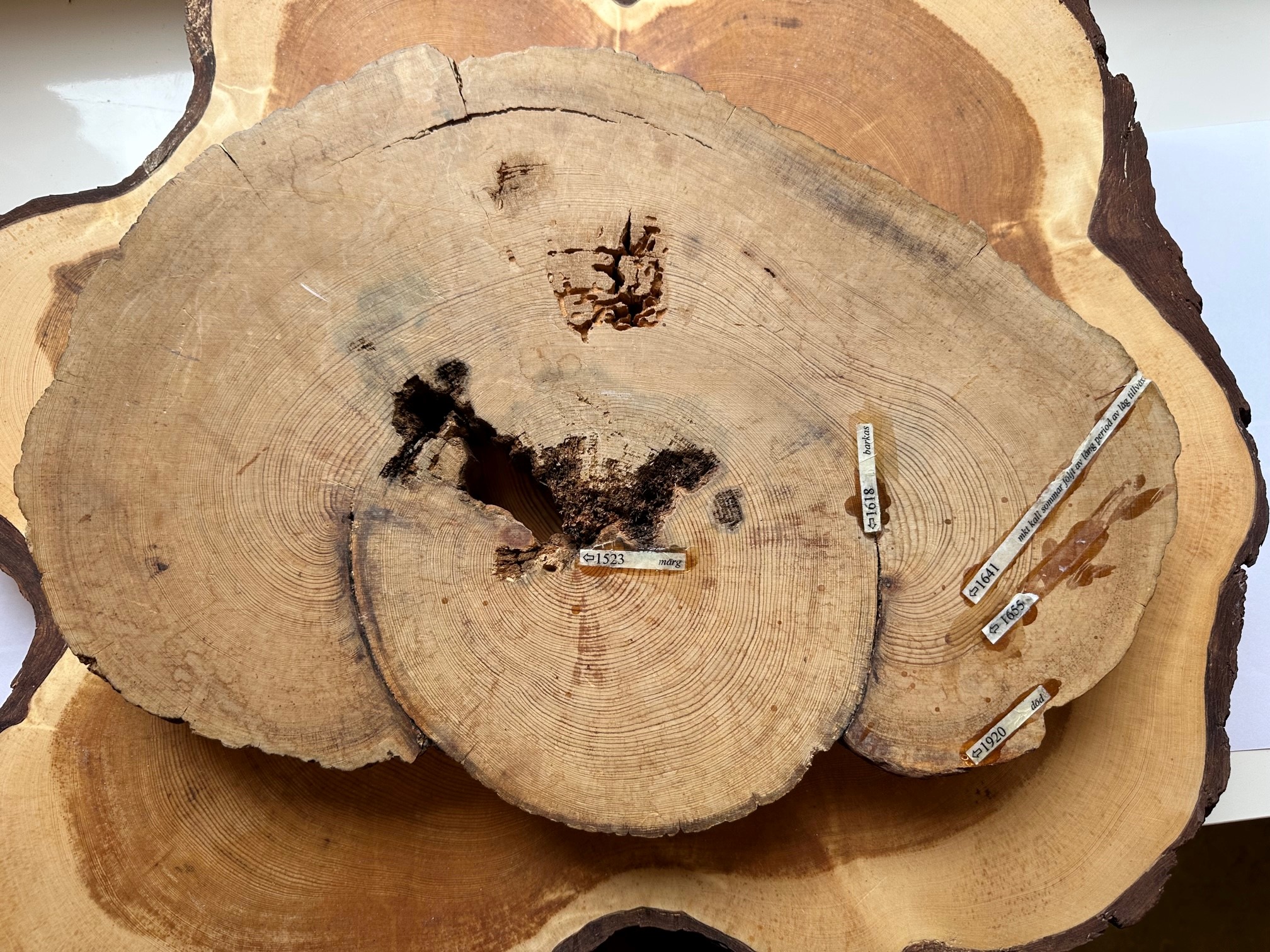
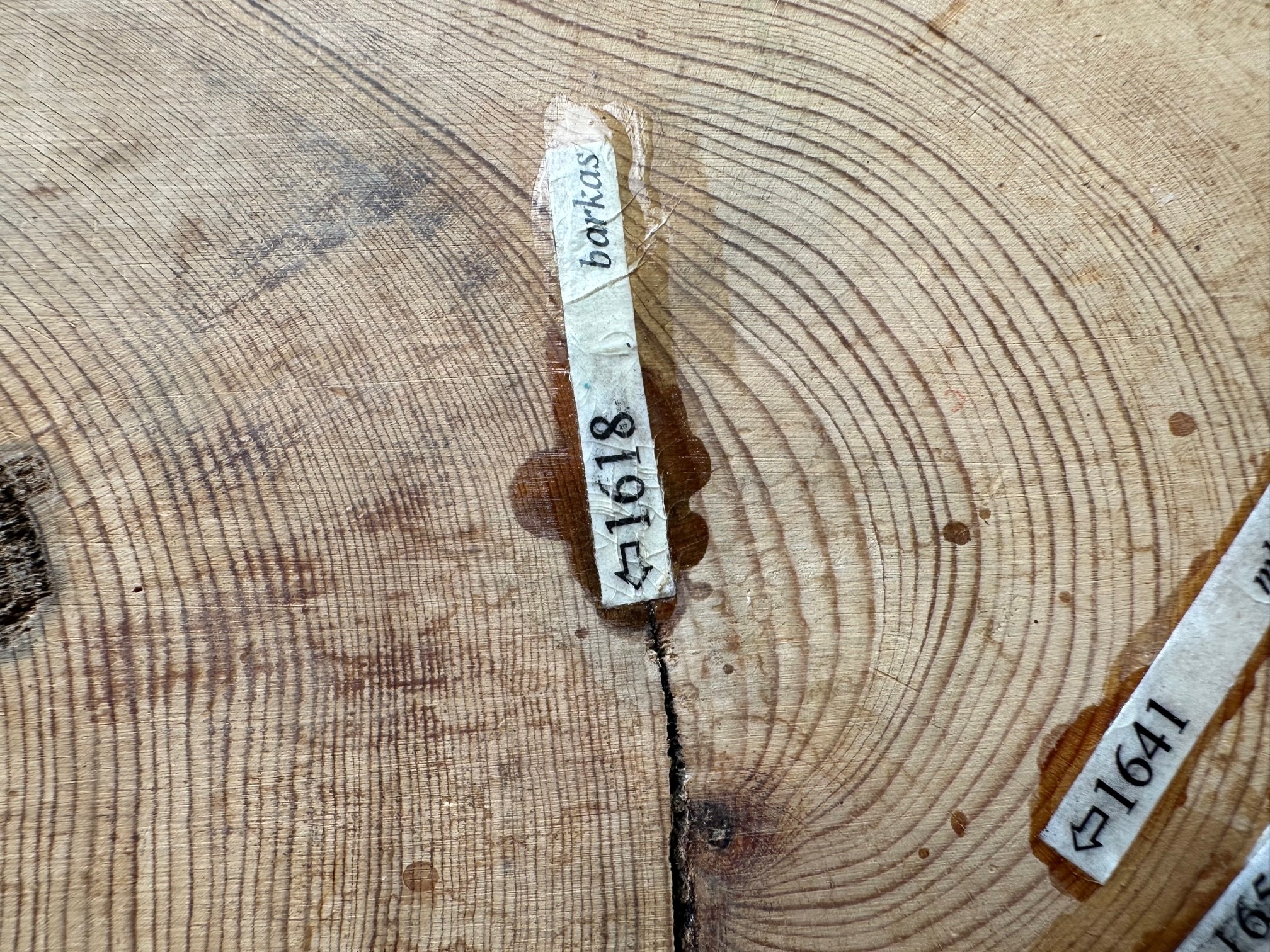
Climate studies and reference in Vattme
In addition to the obvious value as a completely unique natural pine forest, the forest is also an important scientific reference for research. Here, forest scientists can study how a pine forest works when natural processes are given free rein in comparison to production forest. One such example is how a natural pine forest reacts to today's climate changes, another example is the biological diversity that exists in this forest and yet another is how and when regeneration takes place in a natural forest.
Here you can read more about
The toolbox of forest history research and how to combine different methods to understand the history of Vattmes forest
Josefsson, Torbjörn (2009). Pristine forest landscapes as ecological references. Diss. (sammanfattning/summary) Umeå : Sveriges lantbruksuniv., Acta Universitatis Agriculturae Sueciae, 1652-6880 ; 2009:77 ISBN 978-91-576-7424-1
How we use pollen analysis to interpret the history of the forest in Vattme
Josefsson, Torbjörn (2009). Pristine forest landscapes as ecological references. Diss. (sammanfattning/summary) Umeå : Sveriges lantbruksuniv., Acta Universitatis Agriculturae Sueciae, 1652-6880 ; 2009:77 ISBN 978-91-576-7424-1
Josefsson, T., Hörnberg, G. & Östlund, L. 2009. Long-term human impact and vegetation changes in a boreal forest reserve: implications for the use of protected areas as ecological references. Ecosystems 12:1017-1036.
The use of tree rings to see changes in the forest and how humans have used the trees and forest in Vattme
Josefsson, Torbjörn (2009). Pristine forest landscapes as ecological references. Diss. (sammanfattning/summary) Umeå : Sveriges lantbruksuniv., Acta Universitatis Agriculturae Sueciae, 1652-6880 ; 2009:77 ISBN 978-91-576-7424-1
Fassl, Magdalena, 2023. Tree-growth and climate-growth relationships of Scots pine and downy birch in a natural forest in northern Sweden. Avancerad nivå, A2E. Umeå: SLU, Institutionen för skogens ekologi och skötsel
Baudet, M., & Östlund, L. (2022). Collecting Cores to Age Hollow Trees: A Research Note on Scots Pine (Pinus sylvestris). Tree-Ring Research, 78(2), 150-155.
Baudet, M., T. Josefsson, and L. Östlund, 2020. New insights into estimating the age of old Scots pine from increment cores with stem rot. Dendrochronologia 64:125782. https://doi.org/10.1016/j.dendro.2020.125782.
How we’ve used different historical documents to learn about the lives and activities of the Sami population in Vattme
Josefsson, T., Bergman, I., Östlund, L. 2010. Quantifying Sami settlement and movement patterns in Northern Sweden 1700 – 1900. Arctic 63(2): 141-153.


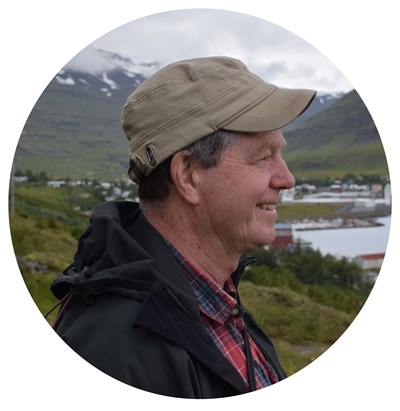
For more information contact
Professor vid Institutionen för skogens ekologi och skötsel; Institutionen för skogens ekologi och skötsel, gemensamt
Besöksadress: Skogsmarksgränd 17, Umeå
